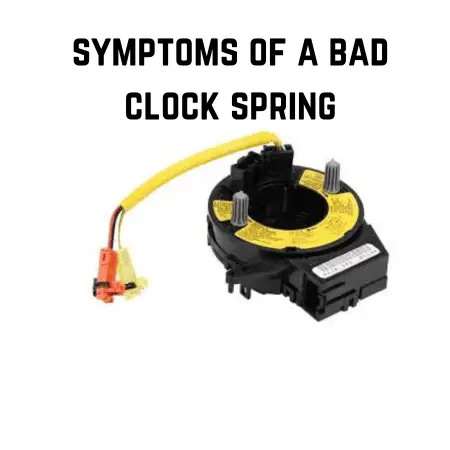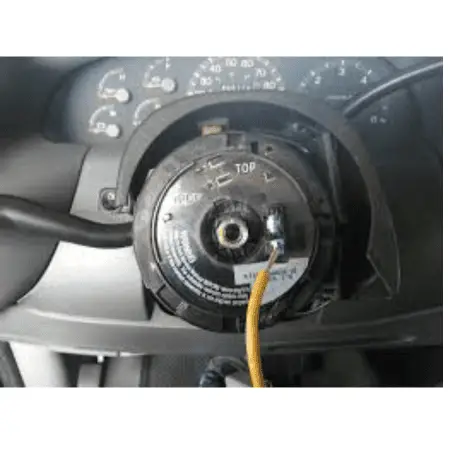Regarding vehicle safety and functionality, few components are as crucial yet overlooked as the clock spring. Understanding the symptoms of a bad clock spring can save you from many problems down the road. Let’s dive into what a clock spring is, the symptoms of its failure, and what you can do about it. So keep on reading…
What is a Clock Spring?
The clock spring, also known as a spiral cable or contact reel, is a crucial part of a vehicle’s airbag system and electrical connections within the steering wheel. It ensures the continuity of electrical circuits between the steering wheel and the vehicle, even as the wheel is turned. Located just behind the steering wheel, the clock spring is responsible for maintaining the connection for the airbag, horn, and various steering wheel controls.
A clock spring consists of a flat ribbon-like cable wound in a spiral shape. As the steering wheel turns, the cable winds and unwinds, maintaining a constant electrical connection between the car’s electrical system and the steering wheel controls. This ensures that even when you turn the wheel, you can still use the horn, airbags deploy correctly, and any other electrical components on the steering wheel work seamlessly.
Must Read
- Airbag Light Comes On And Off While Driving – Reasons & Solutions
- Is It Safe To Drive With ABS Light On? ( Detailed Answer )
- Why Red Light Blinking In Car And What To Do

symptoms of a bad clock spring
Here are the common symptoms to look out for:
1. Airbag Warning Light
One of the first signs is the airbag warning light popping up on your dashboard. This little light isn’t just for show; it’s screaming for attention. When the clock spring fails, it can mess with the connection to the airbag, which means the airbag might not deploy in an accident. It’s like a safety net that has a big hole in it – not good!
2. Non-Functional Steering Wheel Controls
Have you ever tried pressing the buttons on your steering wheel, only to find they’re dead as a doornail? This includes your cruise control, radio controls, and even phone buttons. When the clock spring is faulty, these buttons lose their connection, turning your high-tech steering wheel into a useless decoration.
3. Horn Doesn’t Work
You need to honk at someone during the drive, but your horn decides it’s on vacation. A bad clock spring can cause this too. Since the horn relies on the electrical connection maintained by the clock spring, a faulty one means no more beeping at the car that just cut you off.
4. Strange Noises When Turning the Steering Wheel
If you hear a crunching, clicking, or rubbing noise when you turn the steering wheel, it’s a big red flag. It’s like hearing a rattle in an old toy – something’s definitely off. This noise can be due to the damaged parts of the clock spring rubbing against each other.
5. Illuminated Traction Control or Stability Control Warning Lights
Your car’s computer relies on the clock spring to know the position of the steering wheel. If the clock spring is faulty, it might trigger the traction control or stability control warning lights, indicating the system can’t accurately monitor your wheel position. It’s like trying to walk a tightrope with blurry vision.
6. Inconsistent Turn Signal Operation
Sometimes, you might notice that your turn signals act weirdly or don’t cancel after completing a turn. This can be another sign that your clock spring is on its way out. Think of it as a miscommunication between your intentions and the car’s actions.
Why These Symptoms Matter:
These symptoms might seem annoying, but they’re serious. The clock spring isn’t just a comfort feature – it’s crucial for safety. Ignoring these signs is like ignoring a leaky roof; it might seem fine now, but it’s a disaster waiting to happen.
So, keep an ear out for strange noises, an eye on those warning lights, and make sure all your steering wheel controls are in tip-top shape. Your clock spring is small but mighty – don’t underestimate its importance!

how to Diagnose a Bad Clock Spring
Diagnosing a bad clock spring might sound daunting, but it’s quite manageable if you follow a systematic approach. Here’s a step-by-step guide to help you figure out if your clock spring is the culprit behind your car troubles:
1. Observe the Symptoms
First, take note of any symptoms you’ve been experiencing. This includes:
- The airbag warning light is on.
- Steering wheel controls (like the horn, cruise control, and radio buttons) aren’t working.
- Strange noises when turning the steering wheel.
- Traction control or stability control warning lights are illuminated.
- Turn signals don’t cancel properly.
2. Safety First
Before you start diagnosing, ensure your safety:
- Park the car on a flat surface.
- Turn off the engine.
- Disconnect the battery, starting with the negative terminal. This is crucial to prevent accidental airbag deployment while you’re working.
3. Access the Clock Spring
To get to the clock spring, you’ll need to remove the steering wheel:
- Remove the airbag by unscrewing or unclipping it from the steering wheel. Be cautious and follow your car’s manual to avoid damaging the airbag.
- Disconnect any electrical connectors attached to the airbag.
- Use a steering wheel puller tool to safely remove the steering wheel.
4. Inspect the Clock Spring
With the steering wheel removed, you’ll have access to the clock spring. Look for:
- Visible damage, like broken or frayed wires.
- Loose or disconnected electrical connectors.
- Any signs of wear and tear.
5. Test Electrical Continuity
Using a multimeter, check the continuity of the clock spring’s circuits:
- Set the multimeter to the resistance (ohms) setting.
- Connect the multimeter probes to the clock spring’s connectors. Refer to your vehicle’s wiring diagram for the correct pins to test.
- Rotate the clock spring while checking the readings. There should be a continuous circuit without significant fluctuations.
6. Check for Error Codes
Cars store error codes related to airbag systems and other electrical components. Use an OBD-II scanner to check for any relevant codes:
- Plug the scanner into the OBD-II port (usually located under the dashboard).
- Turn the ignition to the ON position without starting the engine.
- Follow the scanner’s instructions to read the error codes.
- Look for codes related to the airbag system, steering wheel controls, or clock spring.
7. Replace the Clock Spring (if necessary)
If your diagnosis confirms that the clock spring is faulty:
- Purchase the correct replacement part for your vehicle.
- Install the new clock spring following the steps in reverse order: connect the electrical connectors, attach the steering wheel, and reinstall the airbag.
- Reconnect the battery.
8. Test the Repair
After installing the new clock spring:
- Reconnect the battery and start the car.
- Check if the airbag warning light is off.
- Test the steering wheel controls, horn, and turn signals to ensure everything is working properly.
- Use the OBD-II scanner to clear any error codes and verify that no new codes have appeared.
By following these steps, you can effectively diagnose whether a bad clock spring is causing your car’s issues. If you’re not comfortable doing this yourself, it’s always a good idea to consult a professional mechanic.
You May Find Helpful
- How To Clear Engine Derate? Step By Step Guide
- Can Low Oil Cause Misfire? Explained In Detail
- What Should Wheel Bearing Seals Be Checked For?
- How To Clear Service Suspension System? Explained
Conclusion
A bad clock spring can cause a range of issues, from a non-functional horn to a potentially dangerous airbag failure. By recognizing the symptoms early and taking appropriate action, you can ensure your vehicle remains safe and functional. If you suspect a problem with your clock spring, don’t hesitate to get it diagnosed and repaired by a professional.
